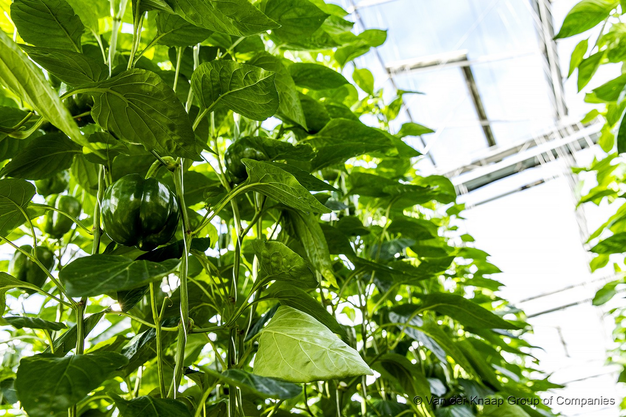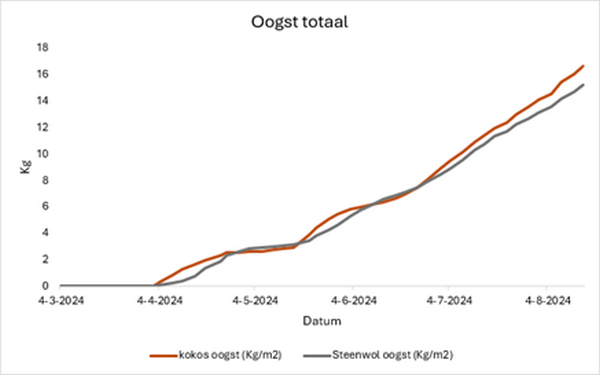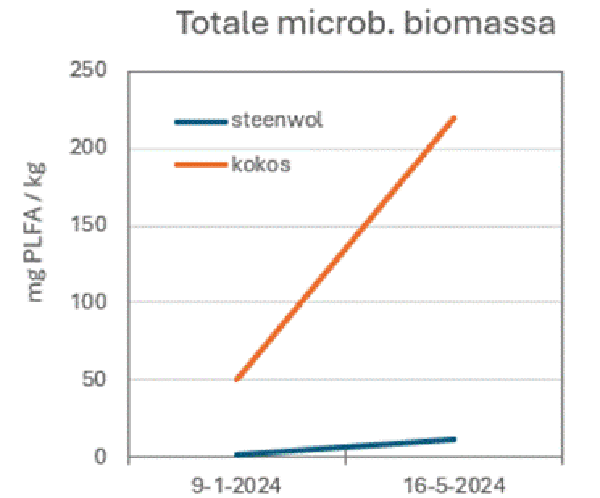Coco substrate is ideally suited to the development of active soil life. This has been proven by the results of several recent trials performed in Forteco innovation centre 'de Kas'. An active soil life is already present in coco substrate and continues to develop rapidly during cultivation.

The latest trial in 'de Kas' involves the comparison of Alzamora RZ variety sweet pepper plants, grown on Forteco Profit coco substrate and stone wool substrate. The trial monitors the plants, harvests, and irrigation. The seeds were sown at the start of November 2023 and planted in early January 2024. The average number of stems per square meter is 6.72. To replicate the practical conditions as closely as possible, the plants are given conventional mineral nutrients on both the coco and stone wool substrate. There is now extensive knowledge and experience in coco substrate cultivation. During regular visits from an experienced grower, advice was received on stone wool-based pepper cultivation.
Observations
Currently, plants on both substrates are performing well. A clear difference in root quality has been observed, as the roots of the plants on the Forteco Profit substrate slabs have a visibly healthier appearance. This difference in quality was particularly noticeable during the first harvest peak in April. While the roots in the stone wool substrate showed clear signs of deterioration, the roots in the coco substrate remained healthy. Although the plants continued to produce new roots during cultivation, this deterioration is clear evidence of reduced resistance and that the variety is more susceptible to pests and diseases.
During the first period, the harvest on stone wool and coco substrate was more or less the same in terms of quantity, with the plants on coco substrate performing slightly better. The fruit weight on the Forteco Profit slabs was higher, with an average of approximately 200 grams. During recent weeks, the harvest from the plants grown on coco substrate has been significantly higher than those grown on stone wool. Although the plants on stone wool initially grew taller, their growth has since stagnated, meaning the plants on both substrates are now the same height.
In practice, problems occur in inert substrates such as stone wool that can lead to crop failure. However, these problems have yet to be encountered with growers using coco substrate. Up to now, no plant mortality has occurred in the trial, either on coco or stone wool substrate. We have observed light yellowing of the plants on stone wool, which could indicate that the plants are having more difficulty absorbing nutrients.

Figure: harvest of the plants on stone wool and coco substrate
Soil life
Soil life is also key to this research project. An active soil life contributes to resilient, stress-tolerant plants that are more resistant to different types of diseases and pests. Eurofins Agro monitors the quality of soil life during the trial. They have developed the Soil Life Monitor for this purpose, which is used to accurately measure the exact number of microorganisms in the soil. They were able to establish that, during cultivation, a richer and more varied microbial life develops in coco substrate than in an inert substrate like stone wool. This is also evident in the results of the pepper trial: not only is there a richer soil life in coco, but it is also more diverse than stone wool.
 Over the past two years, analysis has been performed using the Next Generation Sequencing (NGS) method. This method of analysis allows us to classify the different species of microorganisms found in the substrate and to demonstrate the variety of fungi and bacteria present.
Over the past two years, analysis has been performed using the Next Generation Sequencing (NGS) method. This method of analysis allows us to classify the different species of microorganisms found in the substrate and to demonstrate the variety of fungi and bacteria present.
Figure: difference in microbial biomass between stone wool and coco substrate
For more information: Van der Knaap
Van der Knaap
www.vanderknaap.info
